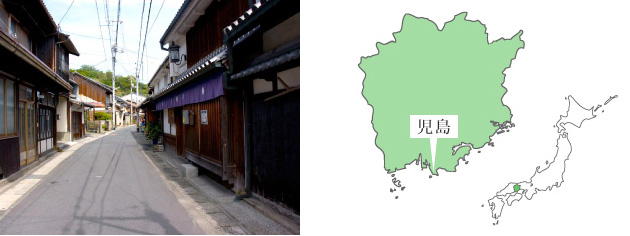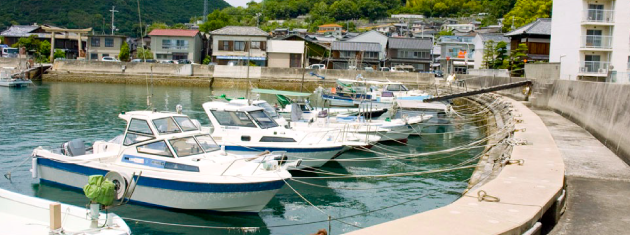
ABOUT KOJIMA
児島のこと
岡山県の南部、児島半島の東岸に位置する児島。
児島は山陰、中国、四国地方の交通の要として交易が盛んな地域でした。
瀬戸内海にかかる瀬戸大橋があり、デニム作りで有名ですが、元々は腰帯に始まり学生服、そして作業着と、繊維産業の盛んな地域でした。
人の行き来が盛んで、地元の繊維産業も繁栄したことから、企業家精神を持っている人間が多いような気がします。
実際に個人事業家も多く、スーパーで「社長~!!」と呼べばみんなが振り向くなんて、真しやかに伝えられています。
児島が発展した経緯から、伝統や文化を大切にする人間が多く、保守的と受け取られるかもしれません。
しかし、これが「職人気質」や「こだわり」となって生かされているのもまた、この地域の愛すべき所だと思っています。
Kojima that is located in the southern part of Okayama Prefecture, the east bank of Kojima Peninsula.
It was the area where the trade with the Sanin Region , Chugoku Region, Shikoku Region were prosperous.
Seto-ohashi across over the Seto Inland Sea.
It is famous for the making of denim. It was the prosperous area of textiles such as the sewing of a waistband and a school uniform and work clothes far back in the past.
It flourished in transport of goods and traffic of people. The local textile prospered, too. In this area, I feel that there many people with the entrepreneurship.
in fact , There are many a private enterprise. Everybody turns around if I call it “the president” in a supermarket.
It may be thought that Kojima is conservative because there are many human beings valuing a tradition and culture.
However, this is expressed in “craftsman spirit” and creates good products.
I think these feelings to be a pleasant point of Kojima.
INDUSTRIAL HISTORY
児島の産業の歴史
「児島」という地名に表れているように、その昔は瀬戸内海に浮かぶ島でした。
江戸時代中期に児島湾で干拓事業が始まりますが、元々が海であったため、塩の残った新田での稲作には適していませんでした。
そこで干拓地に綿花の栽培を始め、先史時代からの主要産業であった製塩業に加えて真田紐や足袋などの生産が始まり、織物業が栄えていきました。
江戸後期には織物業による足袋の販売を元手とした塩田開発が行われ、製塩業も急速に成長します。
明治・大正時代には、製塩業と縫製業が児島に集中し更なる繁栄を遂げます。
足袋の生産では大正時代に全国一の生産量を誇りましたが、第一次世界大戦後、洋装化により足袋の需要が激減、休業企業が続出しました。
この産業危機を救ったのが学生服の生産です。
足袋の裁断・縫製の技術がそのまま学生服の生産に活用され、最盛期には全国シェア約90%にまで成長しました。
しかし、東京オリンピック景気の反動で1960年代より学生服の需要が減少、児島の縫製業は、また時代の厳しい波に揉まれることになります。
1965年、厚手の生地の縫製や染色などの開発を重ね、日本で初めての国産ジーンズ生産が始まります。
日本万国博覧会のあった1970年代より日本国内にジーンズブームが到来し、児島はジーンズの代表的な生産地となりました。
Kojima was the island in the Seto Inland Sea in old days.
Reclamation business begins in Gulf of Kojima in the middle of Edo era.
However, rice growing was not possible in the left fields of the salt.
Therefore people began cultivation of the raw cotton.
The main industrial salt manufacture business and textile work such as braid and the tabi prospered.
The amount of production of the tabi was the highest number across the country. in the Taisho era.
However, after World War I, people came to wear clothes.
Therefore the demand for tabi reduced it.
The people was be able to ride out this industry crisis by the production of school uniforms.
A technique of cutting, the sewing of the tabi was utilized for the production of school uniforms.
It was penetration in Japan Approximately 90%.
However, after the Tokyo Olympics, economy worsened.
The demand for school uniform decreased sharply in the 1960s.
In 1965, we began technology development such as sewing or the dyeing of thick cloth.
And the production of domestic jeans began for the first time in Japan.
Jeans boom came in Japan in the 1970s, and Kojima became the representative place of production of jeans.
ABOUT TANOKUCHI

田の口のこと
弊社の所在地でもある、田の口。ここは、瀬戸内海に面した気候も穏やかな港町です。
江戸時代より、金毘羅参詣・四国遍路・瑜伽山参詣で栄え、繊維業、製塩業で発展しました。
今でも縫製や被服関連の企業が、長い歴史の中で培われてきた技術を受け継ぎながら製品を作っています。
Tanokuchi which is our location. It is a port town facing the Seto Inland Sea here and the climate is mild.
It prospered in pilgrimage to Konpirasan, Shikoku pilgrim, yoga mountain prayer from the Edo era.
And it developed by textile industry, salt manufacture.
Sewing and a clothing-related company make the product which inherited needlework now.

